Abstract
In this paper, we investigate and specify the Bertrand offsets of slant ruled and developable surfaces in Euclidean 3-space . This is accomplished by utilizing the symmetry of slant curves. As a consequence of this, we present the parameterization of the Bertrand offsets for any slant ruled and developable surfaces. In addition to this, we investigate the monarchies of these ruled surfaces and assign them their own unique classification. Also, we illustrate some examples of slant ruled surfaces.
MSC:
53A04; 53A05; 53A17
1. Introduction
In the spatial kinematic, the locomotion of an oriented line embedded linked with a mobile solid body is mostly a ruled surface (). As it is a significant theme of research in vintage differential geometry, it has been appraised by numerous scholars; see [1,2,3,4,5,6,7]. From the geometric point of view, the distinctive characteristics of ruled surfaces and their offset surfaces have been inspected in both Euclidean and non-Euclidean spaces. In the context of line geometry, Ravani and Ku released the theory of Bertrand () curves for [8]. They showed that a can have an infinite number of Bertrand offsets (), much as a plane curve can have an infinite number of matches. Küçük and Gürsoy have specified some descriptions of of trajectory in view of the connections through the projection areas for the spherical curves of and their integral invariants [9]. In [10], Kasap and Kuruoglu obtained the interrelations through integral invariants of the couple of the in Euclidean 3-space . In [11], Kasap and Kuruoglu actuated the research of of in Minkowski 3-space. The involute–evolute offsets of were located by Kasap et al. in [12]. Orbay et al. [13] instigated the search of Mannheim offsets of the . Onder and Ugurlu obtained the relationships through invariants of Mannheim offsets of timelike , and they presented the issues for these surface offsets to be developable [14]. In view of the involute–evolute offsets of ruled surfaces, in [7], Senturk and Yuce designed integral invariants of these offsets via the geodesic Frenet frame [15]. More recently, Yoon explored evolute offsets of the in Minkowski 3-space with stationary Gaussian curvature and mean curvature [16]. Also, Ref. [17] introduced some characterizations for a non-null to be a slant in , and described the relationships between a non-null slant and its striction line. M. Onder and O. Kaya in [18] obtained new characterizations for slant in the Euclidean 3-space. There exist a considerable number of written works on the topic of comprehensive diverse treatises; for instance, [19,20,21,22,23,24]. Nevertheless, to our knowledge, there is no work related to creating of slant via the geometrical properties of the striction curve (. This paper is suggested to assist with such a requirement.
In this paper, a generalization of the helical curves is offered for ruled developable surfaces. Interestingly, the consequences slightly clarify the symmetry among point geometry of helical curves and line geometry of ruled surfaces. If all the rulings of a ruled surface have a stationary angle with a definite line then the ruled surface is a slant ruled surface. Consequently, we defined the of slant ruled and developable surfaces. As administrations of our central repercussions, we used some models to demonstrate the procedure.
Our findings contribute to a deeper understanding of the interplay between spatial movements and ruled surface, with potential applications in fields such as robotics and mechanical engineering.
2. Basic Concepts
In this section, we provide some connotations, including for in Euclidean 3-space that can be found in the textbooks of differential geometry [1,2,3].
A represented surface
such that
is coined a ; is the and the variable u is the arc length of the spherical image . This parametrization provides an opportunity to check the kinematic geometry and pertinent geometric diagnostics. For the geometrical ownerships of , we set up , . Then, the set is the movable Blaschke frame of and the vectors and are designated as the central normal and the asymptotic normal of , respectively. Thus, the Blaschke formula is
where is the Darboux vector, and is the geodesic curvature of . The tangent of the is
, and are referred to as the structure elements of the ruled surface. The geometric ownerships of and are demonstrated as follows: narrates the angle through the tangent to the and the ruling of the surface and is the distribution parameter of . By the differential organization (2)—a non-developable can be realized as follows:
The unit normal vector of is
which is the central normal at the striction point (). The curvature center of is qualified by
Let be the radii of curvature through and . Then,
The geodesic curvature , the curvature and the torsion of fulfil that
where .
Corollary 1.
If is a steady, then is a circle.
Proof.
Via Equation (8) we can figure out that is steady yields that , and is steady straight away, which reveals is a circle (If ) or a great circle (when ). □
Let us have a mobile frame ; be the tangent unit vector to , is the surface unit normal united with , and be the tangent unit to . Thus, we have the following Darboux formulae
Let be the arc length of , that is, . Then,
where
, and are the geodesic curvature, the normal curvature, and the geodesic torsion of , respectively. Thus,
(1) is a geodesic curve if .
(2) is an asymptotic curve if .
(3) is a curvature line if .
Definition 1.
A ruled surface is named a slant ruled surface if all its rulings have a stationary angle with a stationary definite line.
3. Bertrand Offsets of Slant Ruled Surfaces
In this section, we contemplate and discuss of slant ruled surfaces. Then, a theory approximate to the theory of offset curves can be expanded for such surfaces.
3.1. Height Functions
In approximate with [25], a point will be coined a curvature-center of the curve ; for all u such that , but . Here signalizes the k-th derivation of with regard to u. For the first curvature-center of , we find , and . So, is at least a curvature-center of . We now mark a height function , by . We engage the notation for any steady point . Hence, we state the following:
Proposition 1.
Under the above assumptions, we find that:
i—a will be steady in the first estimation if ,, that is,
for real numbers and .
ii—a will be steady in the second estimation if is for the curvature axis of , that is,
iii—a will be steady in the third estimation if is curvature axis of , that is,
iv—a will be steady in the fourth estimation if is curvature axis of , that is,
Proof.
1— For the first derivation of a we find
So, we acquire
for real numbers and , the consequence is evident.
In view of Proposition 1, we have:
- (a)
- The osculating circle of is displayed bywhich are indicated based on the condition that the osculating circle must have a touch of at least the third order at if .
- (b)
- The curve and the osculating circle have a touch of at least the fourth order at if , and .
In this vein, by mediating the curvature centers of , we can obtain a sequence of curvature axes , , …, . The ownerships and the mutual links among these curvature centers are highly enjoyable issues. For instance, it is easy to see that if , , is locating at is steady relative to . In this situation, the curvature center is steady up to the second order, and is described as a slant ruled surface. As a result, we have following theorem:
Theorem 1.
A non-developable is deemed a slant if its geodesic curvature is stationary.
Definition 2.
Let and be two non-developable ruled surfaces in . is defined as an offset of if there exists a bijection through their rulings, such that and have a mutual central normal at the analogical striction points.
Let be a offset of and is the Blaschke frame of as in Equations (2)–(4). Then, the surface can be written as
where
Here, is the distance function among the analogical striction points of and . By the derivation of the Equation (16) via u, we gain
Since at the congruent striction points of and with we gain . This occurs when is steady. Moreover, if is the angle among the rulings of and at the analogical striction points, that is,
By derivation of Equation (18), we obtain
Since and are each other’s , then we have , so that is steady. Since at the analogical striction points of and , it follows that the asymptotic normals of and also have the same steady angle at the matching striction points. Thus, the correlation amidst their Blaschke frames can be written as:
If and , then the are coined to be right offsets and oriented offsets, respectively [8]. The major point to note here is the technique we have applied (compared with [8]). In conclusion, we find that:
Theorem 2.
The offset angle ϕ and the offset distance at the analogical striction points of and are constants.
It is evident from Theorem 2 that a non-developable commonly has a double infinity of . Each can be traced by a steady linear offset and a steady angle offset . Any two surfaces of this pencil of ruled surfaces are alternates of one another; if is a of , then is likewise a of .
Let be the unit normal of . Then, as in Equation (6), we have:
where is the distribution parameter of . It is evident from Equations (5) and (21) that the normal state of and its are not the same. This signifies that the of a are, commonly, not parallel offsets. Therefore, the parallel conditions among in terms of can be described by the next theorem:
Theorem 3.
and are parallel offsets if , their Blaschke frames are collinear.
Proof.
Let , that is, and are parallel offsets. Then, based on Equations (5) and (21), we have
which is hold true for any value , that is, and .
Let the two situations of Theorem 2 hold true, that is, , , and then use them in . Then, we have
which is zero vector, that is, and are parallel offsets. □
Using this method again in the same fashion, but now for developable surface , we have:
Corollary 2.
A developable and its developable are parallel offsets if their Blaschke frames are collinear.
Corollary 3.
A developable and its non-developable cannot be parallel offsets.
Furthermore, we also have
where
By eliminating , we acquire
This is a neoteric version of of ruled surfaces in terms of their geodesic curvatures.
Theorem 4.
and are if the Equation (24) is fulfilled.
Corollary 4.
The of a slant is also a slant .
Corollary 5.
and are parallel offsets if .
Corollary 6.
and are oriented offsets if .
3.2. Construction of Slant Ruled Surface and Its
In this subsection, we describe the construction of slant ruled surface and its .
When is stationary, from the Equations (2) and (7), we have the ODE, . After numerous algebraic manipulations, the solution to this equation is
where . Thus, we immediately find that
Therefore, based on Equations (3), (25) and (26), the is:
Based on Equations (4), (25)–(27) the slant ruled surface has the form
According to the Equations (15), (20) and (27) the surface can be inferred as
where .
3.3. Classification of the Slant Ruled Surfaces
Based on the Equations (28) and (29), and via the shape of the striction curves, the slant and its can be classified into three kinds, as follows; we will consider .
Case 1. If the striction curve is an asymptotic curve, , there are two potential issues:
(a). In the issue of (, then we have
and
For , , and . The slant and its parallel offset are shown in Figure 1. The slant and its oriented offset are shown in Figure 2.
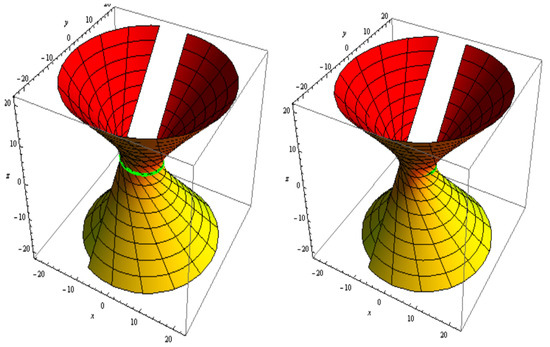
Figure 1.
Slant (left) and its parallel offset (right).
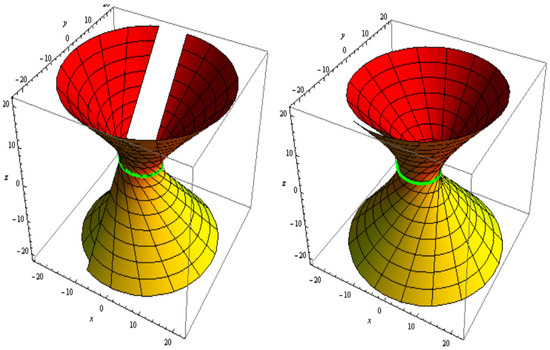
Figure 2.
Slant (left) and its oriented offset (right).
(b). In the issue of (, then we have
and
For , , and , the slant and its parallel offset are shown in Figure 3. The slant and its oriented offset are shown in Figure 4.
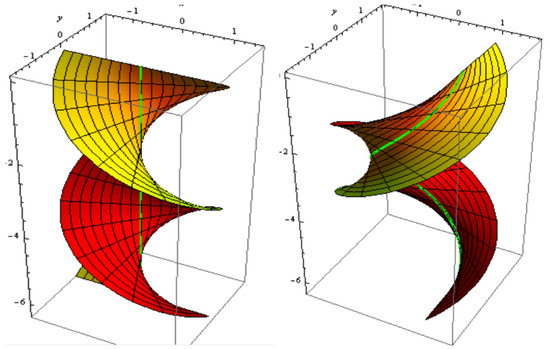
Figure 3.
Slant ruled surface (left) and its oriented offset (right).
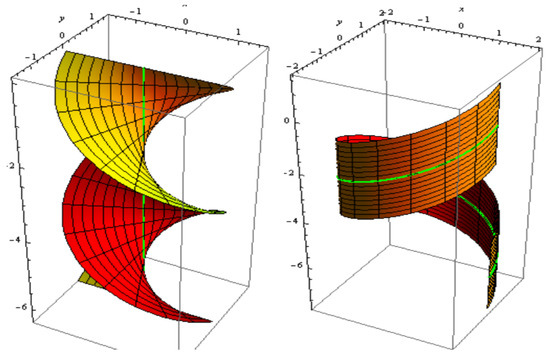
Figure 4.
Slant (left) and its parallel offset (right).
Case 2. If the striction curve is a geodesic curve, we may write
where c is an arbitrary constant. Thus, we may have two different cases:
(a). In the issue of , we have
and
For , and . The slant and its parallel offset are shown in Figure 5. The slant and its oriented offset are shown in Figure 6.
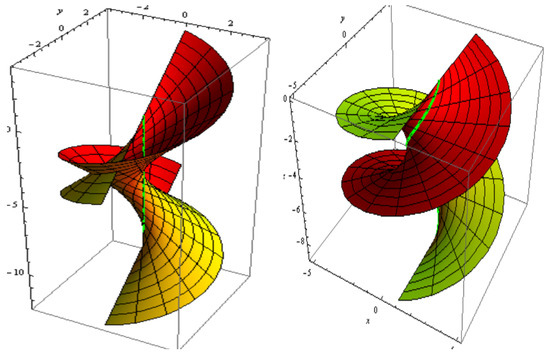
Figure 5.
Slant (left) and its parallel offset (right).
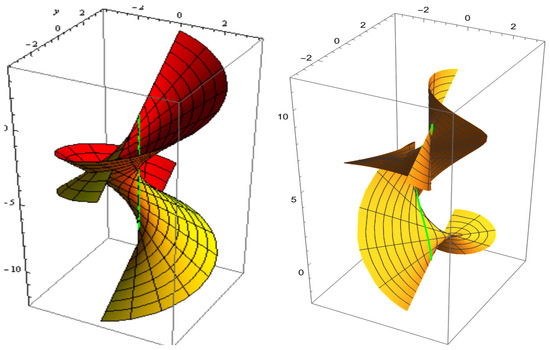
Figure 6.
Slant (left) and its oriented offset (right).
(b). For the issue of , we have
and
For , and . The slant and its parallel offset are shown Figure 7. The slant and its oriented offset are shown in Figure 8.
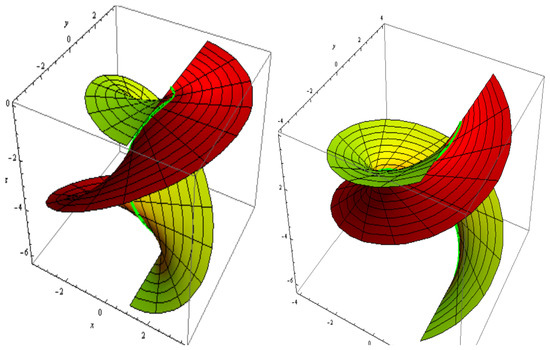
Figure 7.
Slant (left) and its parallel offset (right).
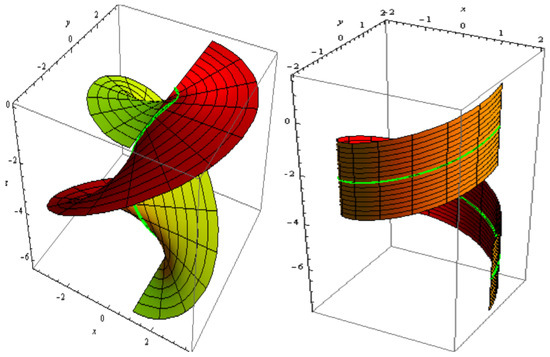
Figure 8.
Slant (left) and its oriented offset (right).
Case 3. If the striction curve is a curvature line, we may write , and we may have two different cases:
(a). In the issue of (, then we have
and
For , and . The slant and its parallel offset are shown in Figure 9. The slant and its oriented offset are shown in Figure 10.
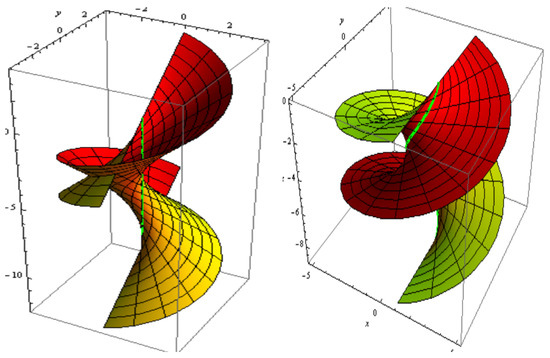
Figure 9.
Slant (left) and its parallel offset (right).
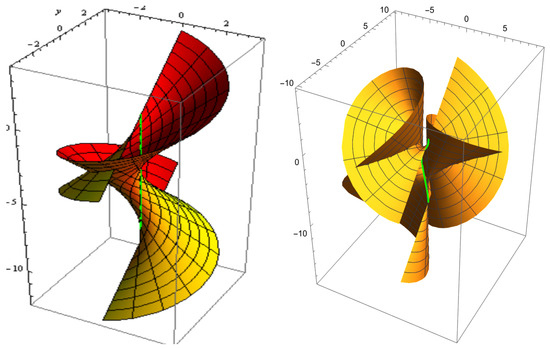
Figure 10.
Slant (left) and its oriented offset (right).
(b). For the issue of (, we have
and
For , and . The slant and its parallel offset are shown in Figure 11. The slant and its oriented offset are shown in Figure 12.
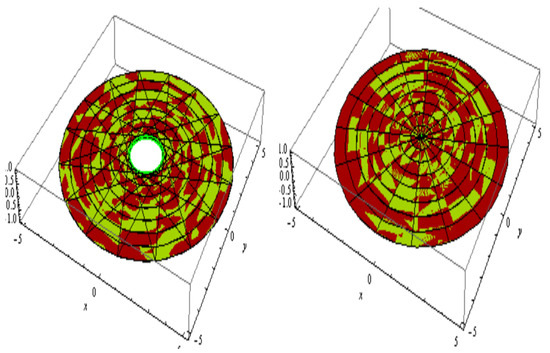
Figure 11.
Slant (left) and its parallel offset (right).
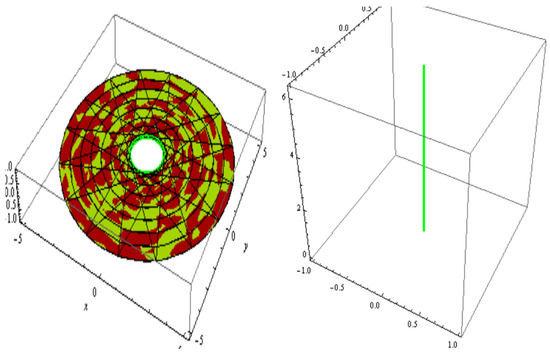
Figure 12.
Slant (left) and its oriented offset (right).
4. Conclusions
This paper develops a theory regarding of slant ruled surfaces analogous to the slant curve theory. In this paper, we legalize the general parameterization of a slant ruled surface in the Euclidean 3-space . In terms of this, we discuss the properties of the position vectors of the for slant ruled and developable surfaces. Hopefully, these scores will be useful in the field of model-based manufacturing of mechanical products, as well as in geometric modeling. The authors plan to apply this work in diverse spaces and discuss the categorization of singularities as they are pointed out in [26,27].
Author Contributions
Conceptualization, R.A.A.-B. and A.A.A.; methodology, R.A.A.-B. and A.A.A.; software, R.A.A.-B. and A.A.A.; validation, R.A.A.-B.; formal analysis, R.A.A.-B. and A.A.A.; investigation, R.A.A.-B. and A.A.A.; resources, R.A.A.-B.; data curation, R.A.A.-B. and A.A.A.; writing—original draft preparation, R.A.A.-B. and A.A.A.; writing—review and editing, A.A.A.; visualization, R.A.A.-B. and A.A.A.; supervision, R.A.A.-B.; project administration, R.A.A.-B.; funding acquisition, A.A.A. All authors have read and agreed to the published version of the manuscript.
Funding
This research was funded by Princess Nourah bint Abdulrahman University Researchers Supporting Project number (PNURSP2024R337).
Data Availability Statement
Our manuscript has no associate data.
Acknowledgments
The authors would like to acknowledge the Princess Nourah bint Abdulrahman University Researchers Supporting Project number (PNURSP2024R337), Princess Nourah bint Abdulrahman University, Riyadh, Saudi Arabia. Also, we would like to thank the reviewers for taking the necessary time and effort to review the manuscript. We sincerely appreciate all your valuable comments and suggestions, which helped us improve the quality of the manuscript.
Conflicts of Interest
The authors declare that there are no conflicts of interest regarding the publication of this paper.
References
- Gugenheimer, H.W. Differential Geometry; Graw-Hill: New York, NY, USA, 1956; pp. 162–169. [Google Scholar]
- Bottema, O.; Roth, B. Theoretical Kinematics; North-Holland Press: New York, NY, USA, 1979. [Google Scholar]
- Karger, A.; Novak, J. Space Kinematics and Lie Groups; Gordon and Breach Science Publishers: New York, NY, USA, 1985. [Google Scholar]
- Papaionnou, S.G.; Kiritsis, D. An application of Bertrand curves and surfaces to CAD/CAM. Comput. Aided Des. 1985, 17, 348–352. [Google Scholar] [CrossRef]
- Schaaf, J.A. Geometric Continuity of Ruled Surfaces. Comput. Aided Geom. Des. 1998, 15, 289–310. [Google Scholar] [CrossRef]
- Peternell, M.; Pottmann, H.; Ravani, B. On the computational geometry of ruled surfaces. Comput.-Aided Des. 1999, 31, 17–32. [Google Scholar] [CrossRef]
- Pottman, H.; Wallner, J. Computational Line Geometry; Springer: Berlin/Heidelberg, Germany, 2001. [Google Scholar]
- Ravani, B.; Ku, T.S. Bertrand offsets of ruled and developable surfaces. Comput. Aided Des. 1991, 23, 145–152. [Google Scholar] [CrossRef]
- Küçük, A.; Gürsoy, O. On the invariants of Bertrand trajectory surface offsets. AMC 2003, 11–23. [Google Scholar] [CrossRef]
- Kasap, E.; Kuruoglu, N. Integral invariants of the pairs of the Bertrand ruled surface. Bull. Pure Appl. Sci. Sect. E Math. 2002, 21, 37–44. [Google Scholar]
- Kasap, E.; Kuruoglu, N. The Bertrand offsets of ruled surfaces in . Acta Math. Vietnam. 2006, 31, 39–48. [Google Scholar]
- Kasap, E.; Yuce, S.; Kuruoglu, N. The involute×-evolute offsets of ruled surfaces. Iran. J. Sci. Tech. Trans. A 2009, 33, 195–201. [Google Scholar]
- Orbay, K.; Kasap, E.; Aydemir, I. Mannheim offsets of ruled surfaces. Math Probl. Eng. 2009, 2019, 160917. [Google Scholar] [CrossRef]
- Onder, M.; Ugurlu, H.H. Frenet frames and invariants of timelike ruled surfaces. Ain. Shams Eng. J 2013, 4, 507–513. [Google Scholar] [CrossRef]
- Sentrk, G.Y.; Yuce, S. Properties of integral invariants of the involute-evolute offsets of ruled surfaces. Int. J. Pure Appl. Math. 2015, 102, 757–768. [Google Scholar] [CrossRef]
- Yoon, D.W. On the evolute offsets of ruled surfaces in Minkowski 3-space. Turk. J. Math. 2016, 40, 594–604. [Google Scholar] [CrossRef]
- Onder, M. Non-Null slant ruled surfaces. Aims Math. 2019, 4, 384–396. [Google Scholar] [CrossRef]
- Onder, M.; Kaya, O. Characterizations of slant ruled surfaces in the Euclidean 3-space. Casp. J. Math. Sci. 2017, 6, 31–46. [Google Scholar]
- Aldossary, M.T.; Abdel-Baky, R.A. On the Blaschke approach of Bertrand offsets of spacelike ruled surfaces. AIMS Math. 2022, 6, 3339–3351. [Google Scholar] [CrossRef]
- Alluhaibi, N.; Abdel-Baky, R.A.; Naghi, M. On the Bertrand Offsets of Timelike Ruled Surfaces in Minkowski 3-Space. Symmetry 2022, 4, 673. [Google Scholar] [CrossRef]
- Nazra, S.; Abdel-Baky, R.A. Bertrand offsets of ruled surfaces with Blaschke frame in Euclidean 3-space. Axioms 2023, 12, 649. [Google Scholar] [CrossRef]
- Mofarreh, F.; Abdel-Baky, R.A. Surface pencil pair interpolating Bertrand pair as common asymptotic curves in Euclidean 3-space. Mathematics 2023, 11, 3495. [Google Scholar] [CrossRef]
- Şentürk, G.Y.; Salim, Y. Bertrand offsets of ruled surfaces with Darboux frame. Results Math. 2016, 72, 1151–1159. [Google Scholar] [CrossRef]
- Şentürk, G.Y.; Salim, Y. On the evolute offsets of ruled surfaces using the Darboux frame. Commun. Fac. Sci. Univ. Ank. Ser. A1 Math. Stat. 2019, 68, 1256–1264. [Google Scholar] [CrossRef]
- Bruce, J.W.; Giblin, P.J. Curves and Singularities, 2nd ed.; Cambridge University Press: Cambridge, UK, 1992. [Google Scholar]
- Almoneef, A.; Abdel-Baky, R.A. Singularity properties of spacelike circular surfaces. Symmetry 2023, 15, 842. [Google Scholar] [CrossRef]
- Nazra, S.; Abdel-Baky, R.A. Singularities of non-lightlike developable surfaces in Minkowski 3-space. Mediterr. J. Math. 2023, 20, 45. [Google Scholar] [CrossRef]
Disclaimer/Publisher’s Note: The statements, opinions and data contained in all publications are solely those of the individual author(s) and contributor(s) and not of MDPI and/or the editor(s). MDPI and/or the editor(s) disclaim responsibility for any injury to people or property resulting from any ideas, methods, instructions or products referred to in the content. |
© 2024 by the authors. Licensee MDPI, Basel, Switzerland. This article is an open access article distributed under the terms and conditions of the Creative Commons Attribution (CC BY) license (https://creativecommons.org/licenses/by/4.0/).